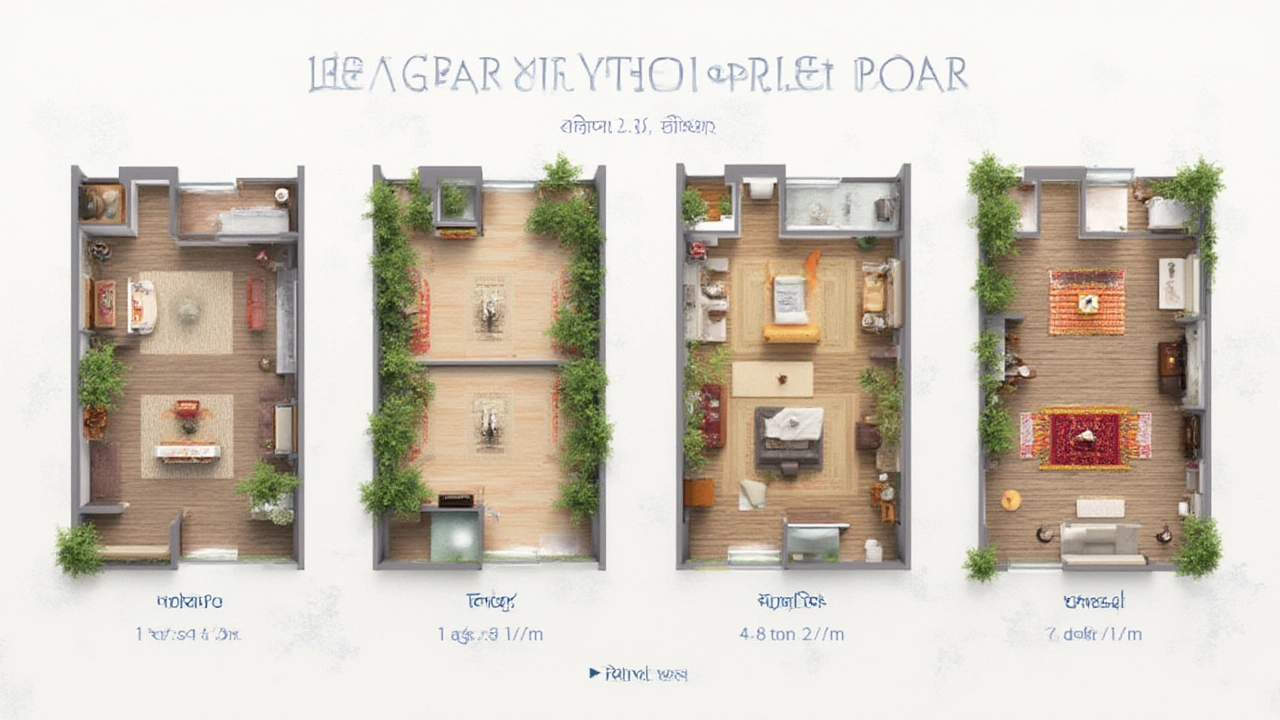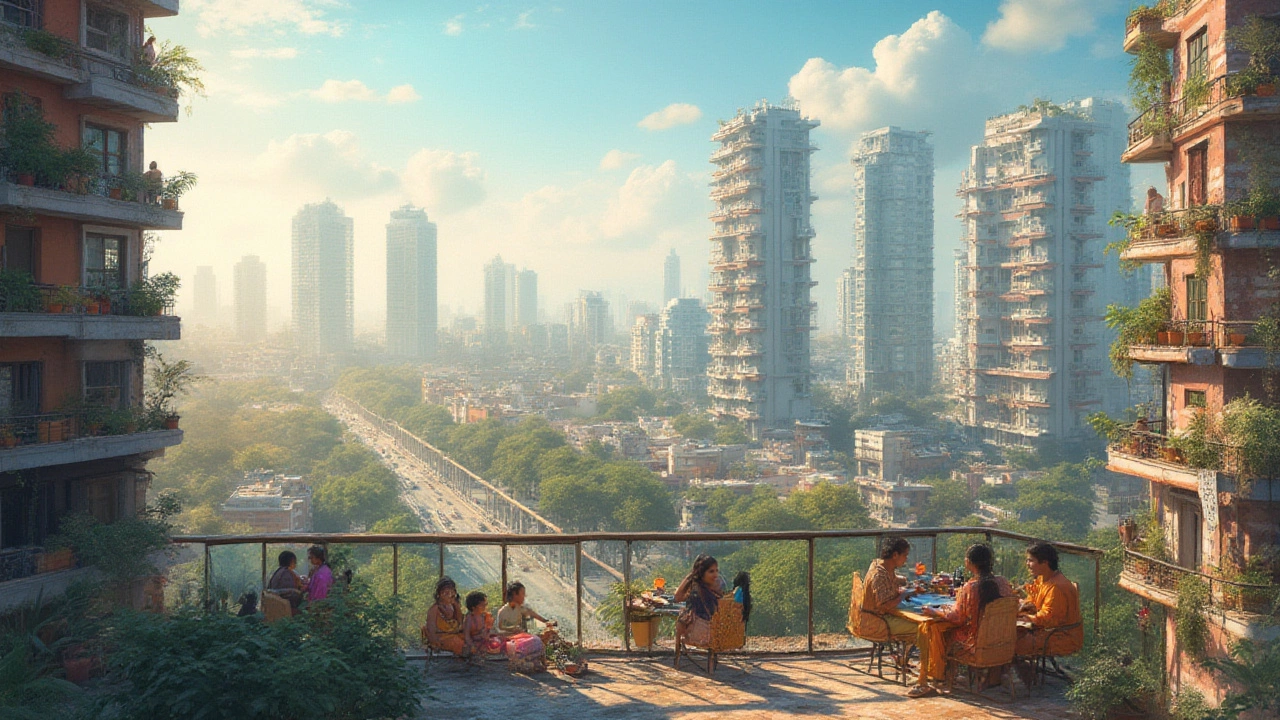Imagine pushing open the door to a new apartment and stepping right into a space that's twice the size of most homes in your city. That instant sigh of relief, the sprawling living room, space to run around—if you’ve only lived in a cramped city flat, this probably sounds like a fever dream. So, where on earth do people actually score these giant apartments, and what makes some cities stand out for sheer living space? Get ready, because the answers aren’t what you think. Spoiler: It’s not always the most expensive cities, and bigger doesn’t always mean bragging rights.
The Global Race for Space: Which Cities Have the Biggest Apartments?
When you think of big apartments, maybe your mind jumps to places like Dubai or New York. But the real heavyweights in square footage are often hiding in plain sight, including mid-sized cities and sometimes even “boring” places you’d never expect. Take Houston, Texas, for instance. According to RENTCafé’s 2024 data, the average size of a new rental apartment here clocks in well over 930 square feet—that’s about 86 square meters! Compare this to Tokyo, where the average new place barely squeaks past 500 square feet. In Australia, even in property-boom Sydney, new apartments are shrinking, with median new builds hovering at just 52–55 square meters (that’s just over 550 square feet).
If you want the kings of space, head to the US South: Atlanta, Dallas, and Charlotte routinely top lists with apartments going up to three times the size of typical Parisian flats. And in the Middle East, Dubai’s super-luxe market offers entire floors as single apartments—some penthouses here can easily surpass 1,500 square meters, but those are lucky exceptions, not the rule.
Curiously, Europe lags far behind. Berlin, London, and Paris, famous for their culture and food, are notorious for shoebox-sized living. Central Paris comes in with an average studio rarely exceeding 30–40 square meters. That's about the size of my garage in Sydney! Even new projects here are careful to maximize every inch due to sky-high land prices.
China is all about tiny, hyper-efficient spaces in megacities like Shanghai, but step into a secondary city like Chengdu or Kunming and you’ll notice a jump in apartment sizes. Russia, especially Moscow, often surprises with roomy apartments built during the Soviet era, designed for large family units. There’s a running joke among my friends that Soviet-era “three-rooms” could almost host indoor soccer!
The reasons behind all this? Local culture, economics, and good old geography. In cities where space is at a premium—think Hong Kong or central London—developers slice and dice every floor. But in Texas or the UAE, wide-open land means builders can spread out and buyers can afford more meters without paying a king’s ransom.
Why Do Apartment Sizes Vary So Wildly Between Cities?
It’s not just about how many people live in a city. Sure, population density matters, but so do local habits, climate, and deep-rooted culture. For example, in Scandinavia and parts of the US, families grow up in bigger apartments because the climate keeps them indoors more often than not—think Swedish winters and Texan summers. Meanwhile, in bustling Asian cities, the tradition leans toward compact, multi-functional living due to population and land scarcity.
Let’s get into the nitty-gritty. The majority of new apartments in American suburban cities begin at 1,000 square feet for a two-bedroom, partly thanks to cheaper land and less restrictive zoning laws. Houston, Phoenix, and Jacksonville often flaunt three or even four-bedroom rentals with sprawling open plans, big enough to host a family movie night and a backyard BBQ in the same afternoon. Here’s a fun one: in the 2024 National Association of Realtors report, the average new apartment built in Southern US cities was 30% larger than a typical city-center London flat. That’s more floor space to trip over your kid’s Legos—and trust me, with a toddler like Vidya running around my Sydney apartment, square footage is not just a luxury; it’s a survival strategy.
Now, think about older cities in Europe. Their cobbled streets, historic facades, and tightly packed blocks mean new large buildings are rare. Paris is a perfect example: rent controls and strict regulations limit what’s built, and people have gotten used to cozy, cleverly designed spaces. Same for Tokyo—amazing public transport and a cultural emphasis on “less is more” shapes the market. A 2019 survey by the Japanese Ministry of Land found the average size of a Tokyo apartment, new or old, stays under 60 square meters.
You also have cities like Dubai, where over-the-top luxury and sheer ambition drive mega-scale developments. In 2023, the Palm Jumeirah’s One at Palm offered apartments averaging nearly 500 square meters. Naturally, this isn’t where most people live—it’s pure luxury. But even average new builds there are comfortably above 100 square meters. The UAE’s focus on attracting expats means they market spacious, well-designed homes as a major selling point.
So, it’s not a simple story of East vs. West, or rich city vs. poor city. Instead, it’s a patchwork: local laws, land prices, building traditions, weather, and even how much time people actually spend in their homes—all shape the typical apartment. This is why someone moving from Sydney to Houston may feel like they just doubled their living room.

The Surprising Underdogs: Cities You Wouldn’t Expect With Massive Apartments
We’ve talked about the superstar cities, but how about the quiet underdogs? Some places quietly win the space race while flying under the radar. Take Calgary, Canada. Most folks picture icy winters here, but locals also luck out on the apartment front. The city’s average new rental is over 900 square feet, and condos often top 1,200. It helps that zoning regulations are looser, and the housing boom never quite drove up prices the way it did in Toronto or Vancouver. A similar vibe exists in Auckland, New Zealand, where new family-sized apartments come with actual kids’ rooms, and some high-rises offer space for home gyms or even a second living area.
Eastern Europe pops up as a surprise. Take Warsaw and Budapest—years of post-Soviet building booms created surprisingly big apartments, partly because families were used to three generations under the same roof. These cities don’t have the same mind-bending real estate prices as Berlin or Paris, so developers can go a bit wild with space. In Budapest, new builds of 80–150 square meters are common for families, and you get a little extra room to breathe for the same price as a tiny Parisian flat.
Then there’s South Africa—Johannesburg’s apartments, especially those built in the last two decades, offer impressive square footage, many with expansive balconies. Developers here often build with families in mind, not just single renters. It’s part of the culture to gather at home, so they make room for everything from dinner parties to two (or three) generations sharing space.
I had a fun chat with a mate who moved from Mumbai to Dubai, and he couldn’t believe how much space he suddenly had. “I spent the first week just walking around to see how big my own living room really was,” he said. It’s moments like these that reshuffle your sense of what ‘normal’ means—after years of living in a tight unit here in Sydney, I get the envy. Even in cities with smaller rentals, clever architecture and open floor plans can make a place feel much bigger than its square-meter count.
So, if you’re dreaming of upsizing, don’t get hung up on the usual suspects. Peer into places that aren’t always on the global radar. You might find a hidden gem where the square meters come free—and more importantly, where you’re not forever bumping elbows with your kids or spouse at breakfast (right, Sanjana?).
Tips for Apartment Hunters: Scoring Big Spaces No Matter the City
If your priority is lots of space, there’s more to consider than just city averages. First, think about location within the city. Central business districts almost always mean tighter quarters, but move even a suburb or two out, and space multiplies. This is especially true in places like Melbourne or Berlin, where peripheral neighborhoods offer way more bang for your buck.
Next, look beyond new builds. In many cities, older apartments—sometimes from decades back—give you more space for less. A 1970s high-rise in Sydney or Chicago can deliver rooms that feel palatial after touring newly built “micro-units.” Just make sure electrical and plumbing upgrades don’t eat up your savings.
Use local forums, Facebook expat groups, and community sites to sniff out larger or “unofficially” subdivided apartments, especially in Europe and Asia where some landlords carve up properties or combine flats. Trust local insight more than what’s splashed on big-name real estate portals. A friend of mine found a Sydney family apartment three streets over at almost half the price per square meter just by asking around on a local parents’ WhatsApp group.
Keep an eye on special deals for longer leases or unfurnished properties. Landlords sometimes offer bigger apartments at a discount when they want tenants who’ll stay put and take good care of the place. This is true even in red-hot markets. In 2025, with housing fluctuating, negotiation is back on the table, especially in cities where the rental market cooled off post-pandemic.
Consider cities—or districts—under redevelopment. In Manchester, UK, old factories are becoming spacious industrial-style lofts. In Warsaw, ex-government buildings are being converted into family-sized rentals. The same is happening in parts of Dallas and southern US cities, where commercial real estate is transforming into affordable, spacious apartments.
If you’re dealing with a smaller space, invest in smart storage, multipurpose furniture, and creative layouts. Modern design tricks—like sliding doors, raised platforms, and bunk beds—help smaller places punch above their weight. Take a cue from Tokyo’s micro-apartment architects, who pack mind-blowing storage into nooks and crannies. Sometimes, it’s not about the meters, but how cleverly you use them.
Finally, don’t forget the biggest apartments often come with a trade-off. You might get tons of room in far-out neighborhoods but face longer commutes or fewer amenities. Decide what matters more: elbow room now, or quick trips to your favorite café. Either way, it’s worth shopping around, especially if you’re moving with a family. I keep an eye out for occasional listings with massive floor plans in Sydney—it doesn’t happen often, but snagging extra space feels like winning the lottery.
